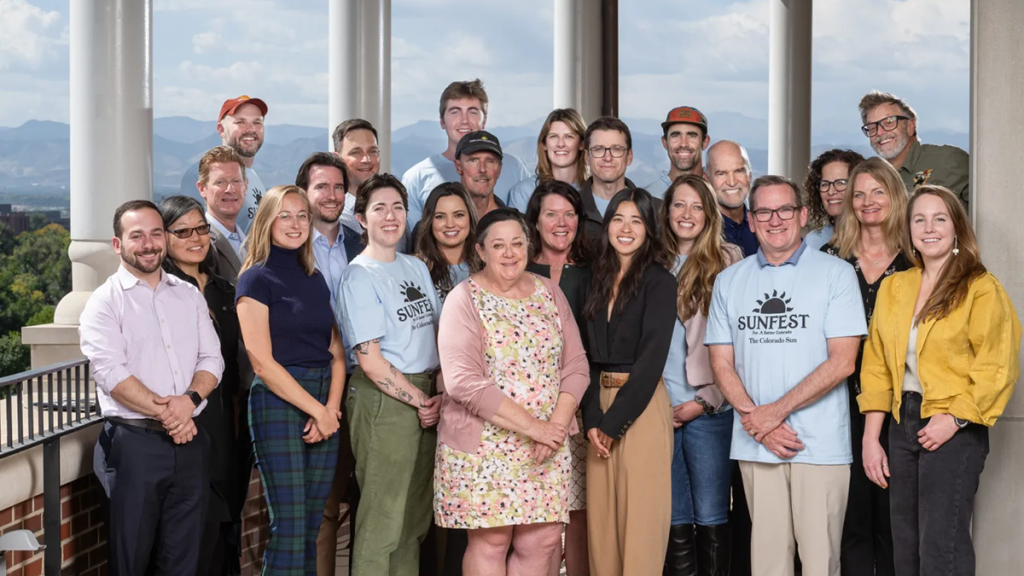
Photo: Andy Colwell | Colorado Sun
How Colorado Sun let employees become their own bosses
The outlet changed its business model to give journalists a “voice and a vote”
The Colorado Sun turned seven in September, and the newsroom has seemingly lived as many lives in that time. Its 10 co-founders, who came from Alden Global Capital’s The Denver Post, first incorporated the news organization as an LLC before quickly pivoting to a for-profit public benefit corporation in 2018. Their initial grant funding came from the now shuttered blockchain start-up Civil, and in 2021 they co-purchased a chain of weekly newspapers before gifting their shares to the National Trust for Local News two years later.
That donation was made in tandem with another critical shift: changing its business structure to a staff-run nonprofit.
Making the transition
While most newsrooms with this model — which are sometimes called employee-directed, worker-led, or worker self-directed nonprofits — build it into their structure from launch day, The Colorado Sun is one of the only to have transitioned after establishing itself as a for-profit, and with a significant team.
It was this growing team that was a driving factor.
“When we first launched, there were 10 owners. We were envisioning a structure similar to a law firm where you have your partners, then you have associates and you’ve got junior partners. If you work hard as an associate, you become a junior partner and then someday you become a partner,” said Larry Ryckman, The Colorado Sun’s Publisher and one of those original co-owners.
“Fast forward five years … and we realized that we had inadvertently created two classes of employees and, more importantly, we hadn’t really articulated what it would take to move from being an employee to becoming a shareholder. If you’re in a law firm, you have to buy into the partnership. We were never going to do that to a group of journalists.”
Assessing their current model, The Colorado Sun team realized they also weren’t getting the most from two benefits of being a for-profit: making a profit (“hello, it’s the news business”) and making endorsements, which they never did. They had none of the upside of being a for-profit, while also constantly having to explain to funders and donors what a public benefit corporation even was.
In 2023, The Colorado Sun became a non-profit. Last year, they received a $1.4 million grant from the American Journalism Project.
What The Colorado Sun’s governance looks like
“We believed, from the very beginning, that journalists should have a voice and a vote in the governance of The Colorado Sun, and so we carried that forward when we decided to become a non-profit,” said Ryckman.
Every staff-run nonprofit newsroom operates uniquely. Each one allows their board and staff to make different decisions, and many have completely different board makeups.
The Colorado Sun practices representative democracy with three critical roles:
- Staff: The body that votes on board members. If necessary, they can call board meetings, change bylaws, and dismiss board members.
- Board: Made up of 3 non-executive staff members and 2 community members who set organizational strategy and approve the budget.
- Executive operating committee: A 4-person team who oversee day-to-day implementation of strategy, as well as set compensation and manage hiring and firing.
There are several unique checks and balances, including:
- All board meetings are open to staff and they can serve on one of several business-focused committees.
- The board sets the compensation for the executive committee.
- The board can remove Ryckman from the executive committee, but only the committee can fire him from the organization.
Each year, staff who have worked at The Colorado Sun for at least 12 months vote for a new staff representative.
“The only way this succeeds as an employee-directed non-profit is for our employees to be involved. And if employees don’t want to be involved [on the board], then we shouldn’t be an employee-directed nonprofit,” said Ryckman. “I’m not in this to prove a thesis that employee-directed is the only way to go. If our employees someday decide that they don’t want to be involved in it then, so be it. Let them vote and change the structure.”
The collaborative benefits of being staff-run
No workplace is a utopia and often the very thing that makes a place great to work, can also become its biggest challenge. That’s no different at The Colorado Sun.
“The benefits of this are that our employees have a voice and a vote. And the downside is our employees have a voice and a vote, right? Democracy can be messy sometimes,” said Ryckman.
“On the one hand, it’s a slower process because you have to build consensus. But that’s a positive thing. And one of the things that I’m most proud of at The Colorado Sun is that it is by far the most collaborative place I have ever worked. It’s no accident.”
For newsrooms that are trying to be more collaborative and have more consensus-based decision-making, he advises that you have to not only want to add your own ideas onto others’, but allow others to do that, too.
“You have to be committed. Are you willing to have your ideas and beliefs and pet projects challenged?” said Ryckman.
The time and energy spent building consensus has led to immense benefits for The Colorado Sun team.
“We had to build consensus, which is slow, which can be frustrating, but ultimately made us stronger. And again, made us more cohesive, made us more collaborative, and I think that that has been the key to [the team] feeling like they have a home here at the Sun and they’re invested in it.”
Cite this article
Chan, Tara Francis (2025, Oct. 2). How Colorado Sun let employees become their own bosses. Reynolds Journalism Institute. Retrieved from: https://rjionline.org/news/how-colorado-sun-let-employees-become-their-own-bosses/
